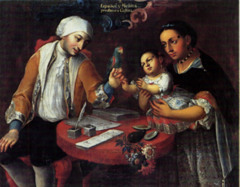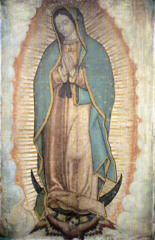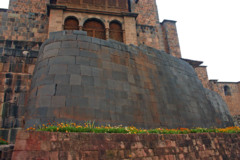casta paintings
Paintings intended to demonstrate the class system in Latin America
Virgen De Guadelupe
Appeared to a boy, and was native like him
Coricancha
The Church of Santo Domingo was built on this to show superiority over the Inca
Pan-Americanism
The idea that all of South America could be governed as a single country and governed as one
mulattoes
African and European
peninsulares
Spanish people born in Spain
creoles
Spanish people born in Latin America
mestizos
Europeans and Amerindians
Cajamarca conflict
When Pizzaro conquered Atahualpa and the Inca
indios
Native Latin Americans
security of worker
During the Inca Empire, when all were in the same class level and if a person was sick or injured they would be cared for by the community
surplus/magazines
If there were extra crops, these were stored in case of emergencies
1520
Year of the fall of the Aztec empire
quipu
These were used by the Inca for record keeping.
1824
Most of the colonies were independent by this year
Tenochtitlan
capital of Aztec empire, now Mexico city
Hernan(do) Cortes
-Crossed from Hispaniola (West Indies) to mainland mexico in seard of gold
-launched the conquest of Aztec Mexico
tribute burden
-Part of Huitzillopochtli religion
-constant sacrificing and warfare
-lead to Aztec revolt, reconquest, and resentment
mita
-"turn" or "rotation"
-every seventh household had to take a turn sending men to the mines
Cuzco
-capital city of Incan empire, where imperial government was
-in civil war at time of Spanish invasion
Christopher Columbus
-The "first" person to discover Americas
-Was trying to reach Asia
Columbian Exchange
-the trade of plants, animals, and diseases between the Old and New Worlds
conquistadores
-"conquerer"
-refers to Spanish soldier-explorers who sought to conquer the New world for the Spanish Crown
advantages of Spaniards
-superior weapons
-horses (scary to natives)
-had battle experience
-history of learning and studying previous battles
Francisco Pizzaro
conquered Atahualpa and the Inca
la Malinche
-Aztec noblewoman who was sold to a Mayan merchant and learned how to speak the Mayan language
-Cortes' translator
-considered traitor to some
Montezuma
-ruler of Aztecs during time of Cortes
-conquered
Atahualpa
-ruler of the Inca Empire
-conquered by Pizarro
mercantilism
-economic system
-colonies exist for benefit of mother country
-money system is weight of gold and silver
quinto
-one fifth of all precious metals mined in the Americas belong to the Crown
encomienda
-crown granted conquerers the right to employ groups of Amerindians
-disguised form of slavery
mining
-main money supply in Americas
-very dangerous but profitable
Potosi
-city where the largest silver mine in South America was located
Council of Indies
-huge bureaucracy in Spain that watched over American colonies
viceroyalty
-four administrative units of Spanish possessions in the Americas
viceroy
-imperial governor of viceroyalties who had broad military and civil authority
-the Spanish sovereign's direct representatives
the four viceroyalties
New Spain, Peru, New Granada, La Plata
audiencia
-twelve to fifteen judges who served as an advisory council and highest judicial body
corregidores
-local officials who held judicial and military power
colonial Church
-converted Amerinians
-taught agriculture
-hospitals, schools
-brought natives into Spanish orbit
Bartolome de las Casas
Spanish missionary who wrote about how the spanish were murdering thousands of natives
New Law of the Indies
-influenced by Bartolome de las Casas
-written by Charles V, Holy Roman Emperor and king of Spain
-says you can no longer have encomiendas (at least, no new ones)
-says you cannot enslave any Indios
Jose Gabriel Condorcanqui/ Tupac Amaru II
-mestizo who had a very successful trading business
-appealed to viceroy and king for the end of mita, and audiencia in Cuzco, native representation in audiencia
-when they did not listen, began a series of executions of corregidores
-captured and executed as he attempts seige of Cuzco
conditions (c. 1800) that led to independence
-mercantilist system does not benefit colonial economies
-protective tariffs imposed by Spain cripple Creole merchants
-Creoles dissatisfied with lack of government jobs they received
-inspired by US independence
-native people wanted change
-pure length of colonial period (~300 years)
Simon Bolivar
-"Latin American George Washington"
-president of Gran Columbia in 1819
-dreamed of Pan-Americanism
-won independence for Latin America
Challenges faced by independent nations
-difficulty acheiving political stability
-Creole leaders had no experience
-military became most powerful in many nations, were not afraid to interfere in civil affairs
-social hierarchy stayed the same even after independence






